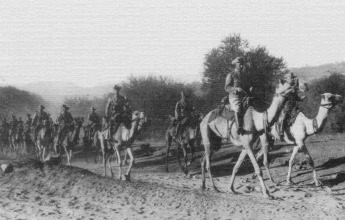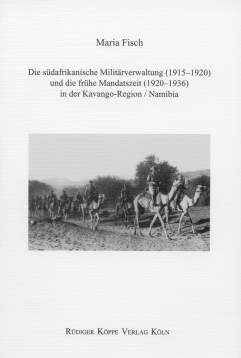

Die südafrikanische Militärverwaltung (1915–1920) und die frühe Mandatszeit (1920–1936) in der Kavango-Region / Namibia
Author: Maria Fisch. Series edited by: Michael Bollig, Wilhelm J.G. Möhlig †.
Series: HSA History, Cultural Traditions and Innovations in Southern Africa Volume 21
2004247 pp.
2 maps, 31 b/w photos, appendices: 1. Contract of capitulation of Khorab [English], 2. Overeenkomst tussen [Generaal S.G.] Maritz en de Goeverneur van Duits Zuidwest-Afrika [Afrikaans with German translation: Übereinkommen zwischen und dem Gouverneur von Deutsch-SWA], 3. Mandate for German South West Africa [English], index of personal and place names
Text language(s): German
Format: 160 x 240 mm
470 g
Paperback
€ 39.80
Buy 'Die südafrikanische Militärverwaltung (1915–1920) und die frühe Mandatszeit (1920–1936) in der Kavango-Region / Namibia' as a downloadable PDF document directly from our online shop »
Order 'Die südafrikanische Militärverwaltung (1915–1920) und die frühe Mandatszeit (1920–1936) in der Kavango-Region / Namibia' as print edition »
The present study analyses two succeeding phases in Namibia’s history when the clash of interests for the natives was progressively vanishing. On the one hand, the British-Southafrican occupation after the German capitulation is described, on the other hand the first stage of the mandate according the peace treaty of Versailles until 1936 is analysed which was increasingly determined by Southafrican colonial interests. After the capitulation of the German colonial force in July 1915, Southwestafrica was assigned to a Southafrican military government which had a mere transitional function and therefore was mainly concerned with keeping peace and order.
Many historians have discussed the reasons and consequences of the only significant military action during this period that was directed against the leader of the Kwanyama and which cost the lives of many of his followers. Almost unnoted remained however what occured in the Northeast of the country.
The Kavango region was not bothered with any consequences of the war and therefore was not occupated. Because of its marginal location it became an attractive place of refuge for people who tried to escape from the new ruling power. This provoced several military actions. Besides, this situation caused continuous border disputes between the Portuguese occupying powers in Angola and the native population which preferred to live on the southern shore of the river since they had to suffer hard life conditions under the Portuguese colonial power.
These border disputes reached their climax between 1916 and 1920 when the financially weak Portuguese government tried to stop emigration with dubious means. Worth mentioning is also the remarkable behaviour of the Kwangali chief Kandjimi who did not resist with violent means but profited from the colonial structure of power with political farsightedness and subtle tactics.
This monograph stands out for a careful study of existent sources and numerous interviews with time witnesses by the author himself (*24th Dec. 1924) who lived and worked in the Kavango region for over 50 years. Furthermore, the author was scholarly counterpart of the Collaborative Research Centre (SFB 389)
(1995–2007), University of Cologne / Germany.
Under these links you will find further studies of languages, cultures and of the history of the Kavango region in today’s Namibia:
Accompanying material:
- A Grammatical Sketch of Rugciriku (Rumanyo)
(ISBN 978-3-89645-542-0 ) - Der Caprivizipfel während der deutschen Kolonialzeit 1890–1914
(ISBN 978-3-89645-050-0 ) - Frühe Kolonialgeschichte Namibias, 1880–1930
(ISBN 978-3-89645-058-6 ) - Herrschaft, Macht und Einfluß
(ISBN 978-3-89645-359-4 ) - The Kavango Peoples in the Past
(ISBN 978-3-89645-353-2 )
Cross-reference:
- A Dictionary of the Rumanyo Language
(ISBN 978-3-89645-601-4 ) - A Grammar of Yeyi
(ISBN 978-3-89645-549-9 ) - Ethnographie des Sprachwechsels
(ISBN 978-3-927620-25-4 ) - Folktales of the Kxoe in the West Caprivi
(ISBN 978-3-89645-081-4 ) - Konzeptualisierung von Landschaft
im Mbukushu (K.333/K.43) Bantusprache in Nord-Namibia)
(ISBN 978-3-89645-600-7 ) - Language Contact, Language Change and History Based on Language Sources in Africa
(ISBN 978-3-89645-093-7 ) - Lucazi Grammar
(ISBN 978-3-89645-038-8 ) - Namibian Languages
(ISBN 978-3-89645-080-7 ) - The Mbukushu in Angola
(ISBN 978-3-89645-350-1 ) - Trommeln in der Kirche
(ISBN 978-3-89645-917-6 )
| « back | Print version | [top] |
 Books
Books Audio
Audio Biographies
Biographies Series
Series Festschrifts
Festschrifts Journals
Journals